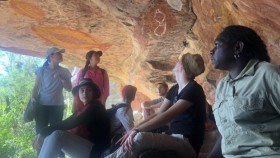Form follows function - or does it?
Form follows function, we are taught, but does it really? This is the question examined in a collaboration between Cathy Franzi, from the ANU School of Art and Design, and Adrienne Nicotra, from the Research School of Biology at ANU.
Cathy spent a year with the Nicotra group, as part of the Vice-Chancellor’s College Artist Fellows Scheme. She worked in the lab, in the glasshouse and in the field, attended lab meetings and even a conference, and became fascinated with the ways plants function in diverse environments, particularly the role of leaves. “The functional significance of leaf shape is still largely unknown, still being investigated,” said Cathy.
The result is a series of exquisitely delicate ceramic vessels, almost translucent, glazed on the inside, and with the imprint of a leaf on the outside. Each vessel represents a species, or a hybrid, and the size corresponds with the leaf size, but many of the vessels have spouts, handles, holes and lips, whose function is unknown, just as the significance of the form in the leaves is currently unknown. In ‘Patterns of Distribution (in leaf shape of Australian Pelargonium species)’, the species are arranged along a latitude gradient, and ‘Patterns of Variation (in leaf shape of Alpine Buttercup species along a moisture gradient)’ includes hybrids between species, collected on a field trip to Kosciusko National Park.
The relationship was rewarding for the Nicotra group as well. “It was fantastic to work with Cathy – it was a real collaboration”, said Adrienne Nicotra. “Some of our conversations led to real moments of thought for me and my students.
“As Cathy’s project came together she explored and captured many elements of what we study – how light passes through the surface of the leaf, how water travels through the veins and their constituent vessel cells, how distinctive the shapes and surface textures of the leaves are. It was simply delightful to participate as the work has come together; it captures the beauty of the leaf as an organ, and also the connections and complexity and eternal curiosity of the relationship between form and function.”
Cathy Franzi’s work will be on display in the atrium of the refurbished RN Robertson building.












